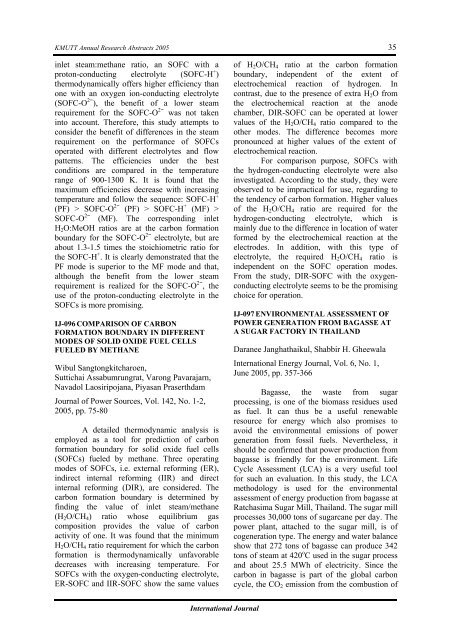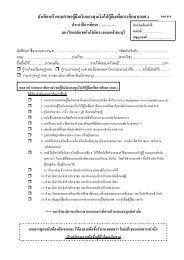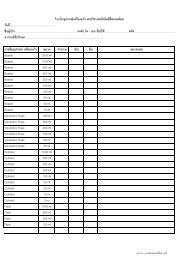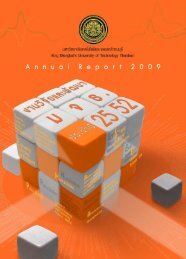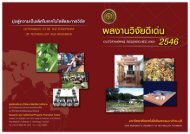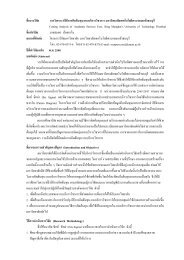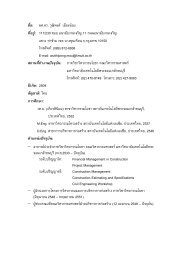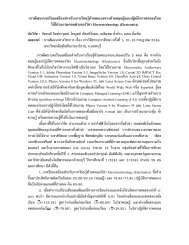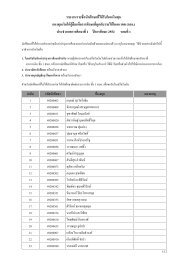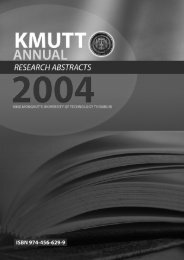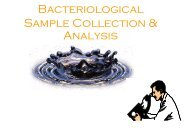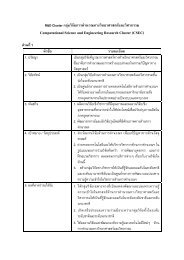You also want an ePaper? Increase the reach of your titles
YUMPU automatically turns print PDFs into web optimized ePapers that Google loves.
KMUTT Annual Research Abstracts 2005<br />
inlet steam:methane ratio, an SOFC with a<br />
proton-conducting electrolyte (SOFC-H + )<br />
thermodynamically offers higher efficiency than<br />
one with an oxygen ion-conducting electrolyte<br />
(SOFC-O 2− ), the benefit of a lower steam<br />
requirement for the SOFC-O 2− was not taken<br />
into account. Therefore, this study attempts to<br />
consider the benefit of differences in the steam<br />
requirement on the performance of SOFCs<br />
operated with different electrolytes and flow<br />
patterns. The efficiencies under the best<br />
conditions are compared in the temperature<br />
range of 900-1300 K. It is found that the<br />
maximum efficiencies decrease with increasing<br />
temperature and follow the sequence: SOFC-H +<br />
(PF) > SOFC-O 2− (PF) > SOFC-H + (MF) ><br />
SOFC-O 2− (MF). The corresponding inlet<br />
H 2 O:MeOH ratios are at the carbon formation<br />
boundary for the SOFC-O 2− electrolyte, but are<br />
about 1.3-1.5 times the stoichiometric ratio for<br />
the SOFC-H + . It is clearly demonstrated that the<br />
PF mode is superior to the MF mode and that,<br />
although the benefit from the lower steam<br />
requirement is realized for the SOFC-O 2− , the<br />
use of the proton-conducting electrolyte in the<br />
SOFCs is more promising.<br />
IJ-096 COMPARISON OF CARBON<br />
FORMATION BOUNDARY IN DIFFERENT<br />
MODES OF SOLID OXIDE FUEL CELLS<br />
FUELED BY METHANE<br />
Wibul Sangtongkitcharoen,<br />
Suttichai Assabumrungrat, Varong Pavarajarn,<br />
Navadol Laosiripojana, Piyasan Praserthdam<br />
Journal of Power Sources, Vol. 142, No. 1-2,<br />
2005, pp. 75-80<br />
A detailed thermodynamic analysis is<br />
employed as a tool for prediction of carbon<br />
formation boundary for solid oxide fuel cells<br />
(SOFCs) fueled by methane. Three operating<br />
modes of SOFCs, i.e. external reforming (ER),<br />
indirect internal reforming (IIR) and direct<br />
internal reforming (DIR), are considered. The<br />
carbon formation boundary is determined by<br />
finding the value of inlet steam/methane<br />
(H 2 O/CH 4 ) ratio whose equilibrium gas<br />
composition provides the value of carbon<br />
activity of one. It was found that the minimum<br />
H 2 O/CH 4 ratio requirement for which the carbon<br />
formation is thermodynamically unfavorable<br />
decreases with increasing temperature. For<br />
SOFCs with the oxygen-conducting electrolyte,<br />
ER-SOFC and IIR-SOFC show the same values<br />
35<br />
of H 2 O/CH 4 ratio at the carbon formation<br />
boundary, independent of the extent of<br />
electrochemical reaction of hydrogen. In<br />
contrast, due to the presence of extra H 2 O from<br />
the electrochemical reaction at the anode<br />
chamber, DIR-SOFC can be operated at lower<br />
values of the H 2 O/CH 4 ratio compared to the<br />
other modes. The difference becomes more<br />
pronounced at higher values of the extent of<br />
electrochemical reaction.<br />
For comparison purpose, SOFCs with<br />
the hydrogen-conducting electrolyte were also<br />
investigated. According to the study, they were<br />
observed to be impractical for use, regarding to<br />
the tendency of carbon formation. Higher values<br />
of the H 2 O/CH 4 ratio are required for the<br />
hydrogen-conducting electrolyte, which is<br />
mainly due to the difference in location of water<br />
formed by the electrochemical reaction at the<br />
electrodes. In addition, with this type of<br />
electrolyte, the required H 2 O/CH 4 ratio is<br />
independent on the SOFC operation modes.<br />
From the study, DIR-SOFC with the oxygenconducting<br />
electrolyte seems to be the promising<br />
choice for operation.<br />
IJ-097 ENVIRONMENTAL ASSESSMENT OF<br />
POWER GENERATION FROM BAGASSE AT<br />
A SUGAR FACTORY IN THAILAND<br />
Daranee Janghathaikul, Shabbir H. Gheewala<br />
International Energy Journal, Vol. 6, No. 1,<br />
June 2005, pp. 357-366<br />
Bagasse, the waste from sugar<br />
processing, is one of the biomass residues used<br />
as fuel. It can thus be a useful renewable<br />
resource for energy which also promises to<br />
avoid the environmental emissions of power<br />
generation from fossil fuels. Nevertheless, it<br />
should be confirmed that power production from<br />
bagasse is friendly for the environment. Life<br />
Cycle Assessment (LCA) is a very useful tool<br />
for such an evaluation. In this study, the LCA<br />
methodology is used for the environmental<br />
assessment of energy production from bagasse at<br />
Ratchasima Sugar Mill, Thailand. The sugar mill<br />
processes 30,000 tons of sugarcane per day. The<br />
power plant, attached to the sugar mill, is of<br />
cogeneration type. The energy and water balance<br />
show that 272 tons of bagasse can produce 342<br />
tons of steam at 420 o C used in the sugar process<br />
and about 25.5 MWh of electricity. Since the<br />
carbon in bagasse is part of the global carbon<br />
cycle, the CO 2 emission from the combustion of<br />
International Journal


